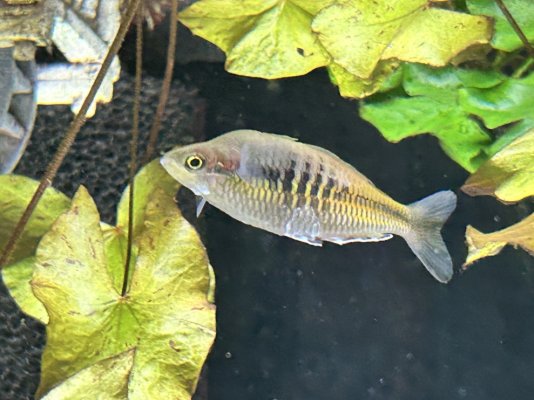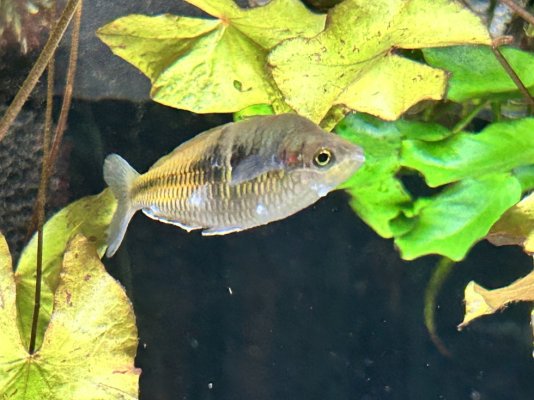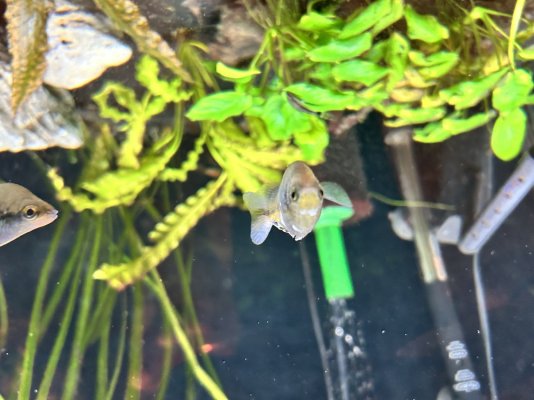I’m trying to figure this out. Possibly injury? Ammonia 0 nitrite 0 nitrate 40 and about to do a big water change.
You are using an out of date browser. It may not display this or other websites correctly.
You should upgrade or use an alternative browser.
You should upgrade or use an alternative browser.
Female boesmani
- Thread starter HicksFam
- Start date
The friendliest place on the web for anyone with an interest in aquariums or fish keeping!
If you have answers, please help by responding to the unanswered posts.
If you have answers, please help by responding to the unanswered posts.
Colin_T
Aquarium Advice Addict
A little more info would be nice  but going off the pictures the fish has excess mucous (creamy coloured patching/ film) all over her body and fins. This is normally caused by poor water quality or chemicals in the water irritating the fish.
but going off the pictures the fish has excess mucous (creamy coloured patching/ film) all over her body and fins. This is normally caused by poor water quality or chemicals in the water irritating the fish.
She also has an infection in the skull (red patch in the head under the skin). This is normally from poor water quality allowing bacteria, protozoa or viruses to flourish and the fish get an infection.
The best treatment for both of these issues is big (75%) daily water changes and gavel cleans for at least one week. Then do it once a week after that. Clean the filter too if it hasn't been done in the last 2 weeks. Wipe the inside of the glass down.
Make sure any new water is free of chlorine/ chloramine before it's added to the tank.
If there's no improvement after a couple of water changes, add some salt (see directions below).
--------------------
Rainbowfish need lots of plant matter in their diet and are more prone to health issues if they don't get enough. At least half their diet should be plant based. You can use vege flakes/ pellets, soft leaf aquatic plants like Ambulia and Duckweed. You can get frozen marine algae from health food stores and Asian supermarkets.
Some brands of frozen bloodworms can cause health issues to rainbowfish. The brands that don't normally cause issues have been irradiated and it will state this on the packet. The irradiated treatment kills most of the bacteria on the bloodworms and makes it much safer for fish. If you use frozen bloodworms, only use it once or twice a week.
--------------------
SALT
You can add rock salt (often sold as aquarium salt), swimming pool salt, or any non iodised salt (sodium chloride) to the aquarium at the dose rate of 1 heaped tablespoon per 20 litres of water. If there is no improvement after 48 hours you can double that dose rate so there is 2 heaped tablespoons of salt per 20 litres.
If you only have livebearers (guppies, platies, swordtails, mollies), goldfish or rainbowfish in the tank you can double that dose rate, so you would add 2 heaped tablespoons per 20 litres and if there is no improvement after 48 hours, then increase it so there is a total of 4 heaped tablespoons of salt per 20 litres.
Keep the salt level like this for at least 2 weeks but no longer than 4 weeks otherwise kidney damage can occur. Kidney damage is more likely to occur in fish from soft water (tetras, Corydoras, angelfish, Bettas & gouramis, loaches) that are exposed to high levels of salt for an extended period of time, and is not an issue with livebearers, rainbowfish or other salt tolerant species.
The salt will not affect the beneficial filter bacteria but the higher dose rate (4 heaped tablespoons per 20 litres) will affect some plants and some snails. The lower dose rate (1-2 heaped tablespoons per 20 litres) will not affect fish, plants, shrimp or snails.
After you use salt and the fish have recovered, you do a 10% water change each day for a week using only fresh water that has been dechlorinated. Then do a 20% water change each day for a week. Then you can do bigger water changes after that. This dilutes the salt out of the tank slowly so it doesn't harm the fish.
If you do water changes while using salt, you need to treat the new water with salt before adding it to the tank. This will keep the salt level stable in the tank and minimise stress on the fish.
When you first add salt, add the salt to a small bucket of tank water and dissolve the salt. Then slowly pour the salt water into the tank near the filter outlet. Add the salt over a couple of minutes.
She also has an infection in the skull (red patch in the head under the skin). This is normally from poor water quality allowing bacteria, protozoa or viruses to flourish and the fish get an infection.
The best treatment for both of these issues is big (75%) daily water changes and gavel cleans for at least one week. Then do it once a week after that. Clean the filter too if it hasn't been done in the last 2 weeks. Wipe the inside of the glass down.
Make sure any new water is free of chlorine/ chloramine before it's added to the tank.
If there's no improvement after a couple of water changes, add some salt (see directions below).
--------------------
Rainbowfish need lots of plant matter in their diet and are more prone to health issues if they don't get enough. At least half their diet should be plant based. You can use vege flakes/ pellets, soft leaf aquatic plants like Ambulia and Duckweed. You can get frozen marine algae from health food stores and Asian supermarkets.
Some brands of frozen bloodworms can cause health issues to rainbowfish. The brands that don't normally cause issues have been irradiated and it will state this on the packet. The irradiated treatment kills most of the bacteria on the bloodworms and makes it much safer for fish. If you use frozen bloodworms, only use it once or twice a week.
--------------------
SALT
You can add rock salt (often sold as aquarium salt), swimming pool salt, or any non iodised salt (sodium chloride) to the aquarium at the dose rate of 1 heaped tablespoon per 20 litres of water. If there is no improvement after 48 hours you can double that dose rate so there is 2 heaped tablespoons of salt per 20 litres.
If you only have livebearers (guppies, platies, swordtails, mollies), goldfish or rainbowfish in the tank you can double that dose rate, so you would add 2 heaped tablespoons per 20 litres and if there is no improvement after 48 hours, then increase it so there is a total of 4 heaped tablespoons of salt per 20 litres.
Keep the salt level like this for at least 2 weeks but no longer than 4 weeks otherwise kidney damage can occur. Kidney damage is more likely to occur in fish from soft water (tetras, Corydoras, angelfish, Bettas & gouramis, loaches) that are exposed to high levels of salt for an extended period of time, and is not an issue with livebearers, rainbowfish or other salt tolerant species.
The salt will not affect the beneficial filter bacteria but the higher dose rate (4 heaped tablespoons per 20 litres) will affect some plants and some snails. The lower dose rate (1-2 heaped tablespoons per 20 litres) will not affect fish, plants, shrimp or snails.
After you use salt and the fish have recovered, you do a 10% water change each day for a week using only fresh water that has been dechlorinated. Then do a 20% water change each day for a week. Then you can do bigger water changes after that. This dilutes the salt out of the tank slowly so it doesn't harm the fish.
If you do water changes while using salt, you need to treat the new water with salt before adding it to the tank. This will keep the salt level stable in the tank and minimise stress on the fish.
When you first add salt, add the salt to a small bucket of tank water and dissolve the salt. Then slowly pour the salt water into the tank near the filter outlet. Add the salt over a couple of minutes.
What Colin says. He knows his fish.
I do 50-60% water changes in my tanks once a week, occasionally more, like now because I have an old 8” Oscar in a 56 G. She will be moved to a 125 G on Sunday.
How big is your tank and how much & how often do you change the water?
I do 50-60% water changes in my tanks once a week, occasionally more, like now because I have an old 8” Oscar in a 56 G. She will be moved to a 125 G on Sunday.
How big is your tank and how much & how often do you change the water?
Similar threads
- Replies
- 1
- Views
- 476
- Replies
- 11
- Views
- 326
- Replies
- 1
- Views
- 491
- Replies
- 6
- Views
- 445
Latest posts
-
-
-
Forum Update - We're back! Ask your questions here.
- Latest: Flaxon-Waxon
-
-
-
-
Little Back Story on Az Fish Rescue Pendley's Plentiful Pets
- Latest: Andy Sager
-



